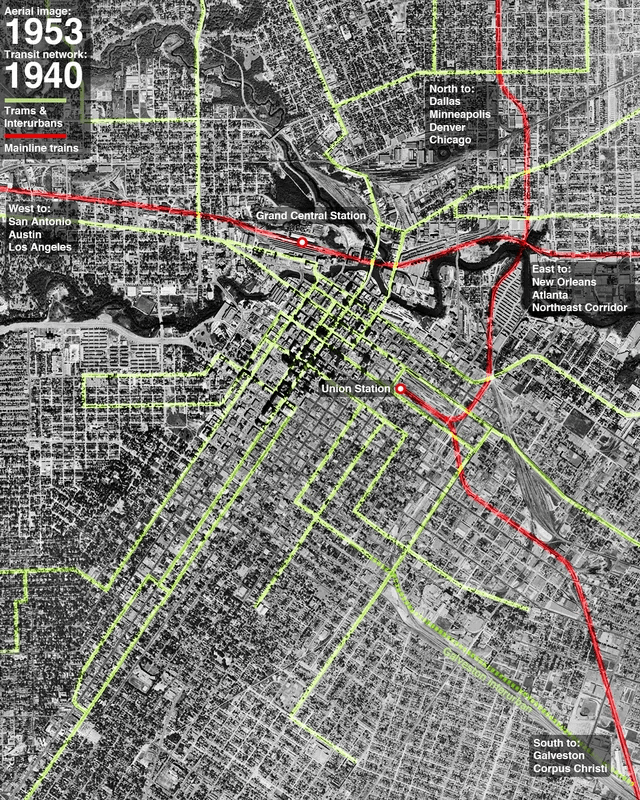Public transportation in Houston has evolved dramatically since the late 19th century, transitioning from a streetcar system to a comprehensive public transit network that includes buses and light rail. This transformation reflects the city’s growth, technological advancements, and the changing needs of its residents.
Early Beginnings: The Rise of Streetcars
The origins of public transportation in Houston can be traced back to 1891, when the first horse-drawn streetcars began operating. As the city grew, so did the need for reliable transportation. The transition to electric streetcars marked a pivotal moment in Houston’s history. By the turn of the century, the city boasted an extensive streetcar network, with over 100 miles of tracks connecting neighborhoods and commercial districts.

These streetcars not only facilitated mobility but also played a significant role in shaping the urban landscape. Neighborhoods developed along streetcar lines, promoting residential growth and commercial activity. Houston’s streetcars became a social hub, fostering connections among residents and contributing to the city’s vibrant community life.
Challenges Faced by the Streetcar System
However, the streetcar system faced challenges as the popularity of the automobile surged in the mid-20th century. As families acquired cars, the demand for streetcars dwindled. By 1940, the last streetcar line in Houston was shut down, signaling the end of an era. The city began to adapt to the changing transportation landscape, focusing more on accommodating vehicles than public transit.
Transition to Buses: A New Era
With the decline of streetcars, buses emerged as the primary mode of public transportation in Houston. The first bus service was introduced in 1940, providing residents with a flexible and efficient way to navigate the city. Buses quickly gained popularity, offering routes that could adapt to the city’s growth.
Expansion of the Bus Network
Throughout the 1950s and 1960s, the bus network expanded significantly. The Houston Transit Company emerged as a key player, enhancing services and reaching previously underserved areas. Buses became vital in connecting residents to jobs, schools, and essential services.
This transition also brought about improvements in accessibility. Low-floor buses and accommodations for individuals with disabilities helped make public transportation more inclusive, ensuring that all residents could benefit from the system.
Establishment of METRO: A Comprehensive Transit Authority
In 1979, the establishment of the Metropolitan Transit Authority (METRO) marked a new chapter in Houston’s public transportation history. METRO was created with a vision to develop a comprehensive transit system that would serve the growing population and integrate various modes of transport, including buses and light rail.

The Light Rail Initiative
One of METRO’s most significant milestones was the introduction of light rail in 2004. The Main Street Line connected key areas such as downtown, the Museum District, and Texas Medical Center. This addition signified a revival of rail-based transit in Houston, offering a reliable alternative for commuters.
The light rail system continued to expand, with additional lines and stations being developed to meet the needs of a diverse and growing population. The integration of light rail with existing bus services created a more cohesive transit experience, allowing riders to easily transfer between different modes of transportation.
Modern Innovations and Future Directions
Despite its progress, Houston’s public transportation system still faces challenges. Traffic congestion remains a pressing issue, and the demand for efficient public transit continues to grow. In response, METRO has embraced technological advancements to improve the overall rider experience.
Embracing Technology
METRO has implemented several innovations, including real-time tracking of buses and trains, mobile applications for trip planning, and contactless payment options. These enhancements not only increase convenience but also encourage more residents to consider public transit as a viable option for their daily commutes.
Sustainability Initiatives
Furthermore, METRO is committed to sustainable practices. The introduction of electric buses and bike-sharing programs demonstrates a commitment to reducing carbon emissions and promoting eco-friendly transportation alternatives. These initiatives aim to create a more sustainable and environmentally friendly public transportation system for Houston.
The Future of Public Transportation in Houston
As Houston continues to grow, the importance of a robust public transportation system becomes increasingly apparent. Ongoing population growth and urban development necessitate efficient and reliable transit options to meet the needs of residents.
Plans for Expansion
Looking ahead, METRO has plans for further expansion of its services, including new light rail lines and enhanced bus routes. These developments aim to connect major employment centers, educational institutions, and residential neighborhoods, fostering a more interconnected community.
A Vision for Community Connectivity
Ultimately, the history of public transportation in Houston reflects the city’s evolution and commitment to connectivity. By embracing new technologies and fostering a culture of inclusivity, Houston can build a public transportation system that meets the needs of its residents for years to come.